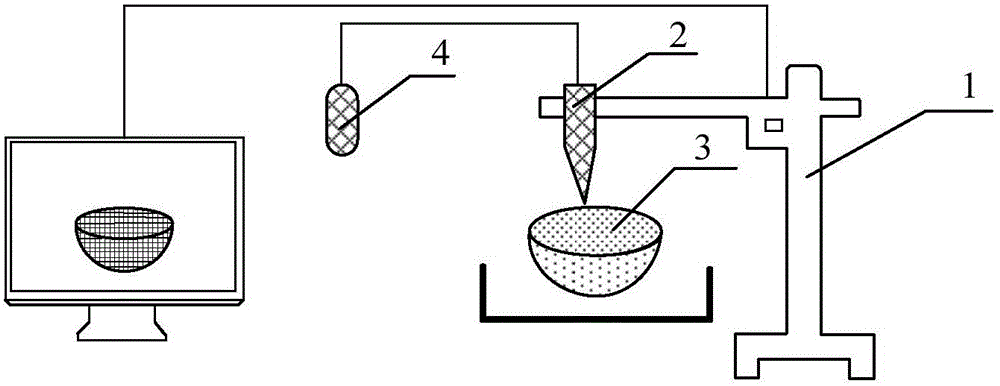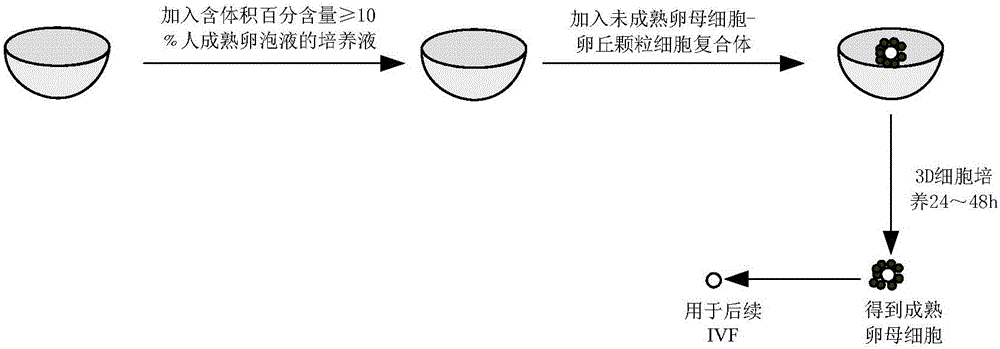Method for promoting in-vitro maturing of human immature oocyte by utilizing 3D printing technology
A 3D printing and oocyte technology, applied in the field of biological 3D printing, can solve the problems affecting the maturation process of oocyte culture in vitro, and achieve the effect of strong repeatability and good stability
- Summary
- Abstract
- Description
- Claims
- Application Information
AI Technical Summary
Problems solved by technology
Method used
Image
Examples
Embodiment 1
[0035]Example 1 Using sodium alginate hydrogel to construct artificial granulosa cell hemispheres to promote the maturation of immature oocytes
[0036] Put the collected granulosa cells into a cell culture flask for culture, the medium is TCM199 medium, add 10% fetal bovine serum and 0.1% penicillin-streptomycin mixture, place at 37°C with 5% CO 2 Cultivate in the incubator for 3-7 days, take the cells in the logarithmic growth phase and digest them with 0.25% trypsin, resuspend the cells and mix them evenly with sodium alginate, add 0.02M Ca 2+ Stand to form a hydrogel, and the final concentration of granular cells in each mL of hydrogel is about 10 5 pieces.
[0037] The granulosa cell-sodium alginate hybrid gel is used as ink for three-dimensional printing, and the printed graphics are precisely designed using computer-aided design technology. According to the shape of the follicle, a bowl-shaped structure is designed, such as figure 1 As shown in the figure, 1 is the XY...
Embodiment 2
[0042] Example 2 Using collagen hydrogel to construct artificial granulosa cell hemispheres to promote the maturation of immature oocytes
[0043] Put the collected granulosa cells into a cell culture flask for culture, the medium is TCM199 medium, add 10% fetal bovine serum and 0.1% penicillin-streptomycin mixture, place at 37°C with 5% CO 2 Cultivate in the incubator for 2-7 days, take the cells in the logarithmic growth phase and digest them with 0.25% trypsin. The concentration of granule cells is 10 7 pieces.
[0044] The granulosa cell-collagen hybrid gel is used as ink for three-dimensional printing, and computer-aided design technology is used to accurately design the printed graphics. According to the shape of the follicle, it is designed into a bowl-shaped structure. The wall of this hemispherical structure is made of granulosa cells mixed with collagen hydrogel, with a diameter of 10 mm and a wall thickness of 100 μm, so as to simulate the wall granulosa cells in ...
Embodiment 3
[0049] Example 3 Using gelatin hydrogel to construct artificial granulosa cell hemispheres to promote maturation of immature oocytes
[0050] Put the collected granulosa cells into a cell culture flask for culture, the medium is TCM199 medium, add 10% fetal bovine serum and 0.1% penicillin-streptomycin mixture, and place in a 37°C 5% CO2 incubator for 3- On the 7th, the cells in the logarithmic growth phase were digested with 0.25% trypsin, and the cells were resuspended and mixed with gelatin solution (dissolved in hot water at 65-70°C and then cooled down to about 37°C) and mixed evenly at 35°C. Set into a hydrogel, the final particle cell concentration in each mL of hydrogel is 10 6 pieces.
[0051] The granulosa cell-gelatin hybrid gel is used as ink for three-dimensional printing, and the printed graphics are precisely designed using computer-aided design technology. According to the shape of the follicle, it is designed into a bowl-shaped structure. The wall of this he...
PUM
| Property | Measurement | Unit |
|---|---|---|
| diameter | aaaaa | aaaaa |
Abstract
Description
Claims
Application Information
 Login to View More
Login to View More - Generate Ideas
- Intellectual Property
- Life Sciences
- Materials
- Tech Scout
- Unparalleled Data Quality
- Higher Quality Content
- 60% Fewer Hallucinations
Browse by: Latest US Patents, China's latest patents, Technical Efficacy Thesaurus, Application Domain, Technology Topic, Popular Technical Reports.
© 2025 PatSnap. All rights reserved.Legal|Privacy policy|Modern Slavery Act Transparency Statement|Sitemap|About US| Contact US: help@patsnap.com


